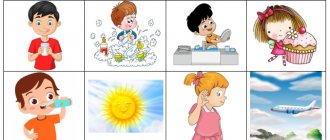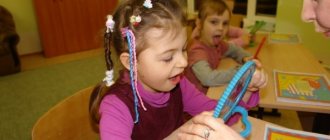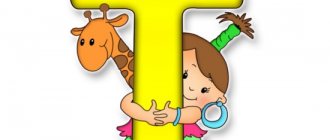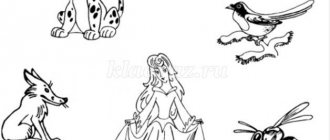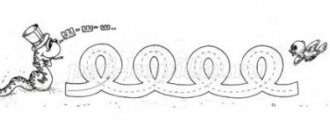1. Pronunciation of the sound [S] 2. The difference between the articulation of the sound [Z] and the sound [S] 3. Articulation of the sound [C] 4. Methods of setting the sounds [S], [Z], [C] step by step 4.1. Lip exercises 4.2. Gymnastics for the tongue 4.3. Breathing exercises 5. Second stage of production 6. Automation of sounds [S], [Z], [C]. Working with cards.
Work to eliminate the shortcomings of pronouncing the sounds [С], [З], [Ц] in most cases requires lengthy and painstaking actions. The teacher needs to clearly imagine the correct articulation of these sounds.
Pronouncing the sound [S]
- the lips slightly stretch into a smile, except in those cases when the subsequent phonemes are the vowels [O] and [U], which leads to anticipatory rounding of the lips;
- the teeth are either compressed or brought together, leaving only a narrow gap (about 1-2 mm);
- the tip of the tongue rests on the gums of the lower incisors, its back is curved, and the lateral edges are adjacent to the upper molars;
- along the tongue, in its middle, a groove is formed, which at the alveoli opens outwards with a narrow round hole;
- the soft palate is raised and closes the passage of air into the nasal cavity;
- The vocal cords are open and freely allow exhaled air to pass into the pharyngeal and oral cavities. The air stream is narrow, cold, strong.
What to do at the differentiation stage
At the differentiation stage, correction of parasigmatisms is carried out. The speech therapist or parents offer tasks for phonemic processes. An adult must pronounce sounds clearly and emphasize them strongly with his voice. This is due to the fact that if the child pronounced the mixed sound incorrectly, then he heard the phoneme distorted.
If it is difficult for him to identify the desired phoneme by ear, offer to repeat it after an adult. Gradually, the baby will learn to complete the task by ear. Offer to find a phoneme in syllables and words. Pay attention to articulation, especially if you rely on pronunciation when performing exercises.
Work on the sound analysis of the word. Explain to your child where the beginning, middle and end of the word are, what sounds are called consonants and vowels. Be sure to characterize C, practice identifying the place of the phoneme in syllables. Then start working with words.
Invite your child to divide the pictures into groups with certain phonemes. First choose phonemes that are completely different in acoustic and articulatory characteristics. Then, when you reinforce the correct pronunciation of words, include phonemes from the same group (C and C) in your lessons.
Carry out correction work gradually; there is no need to burden the baby with a lot of information. It is step-by-step that is an important component of successful training.
Methods for setting sounds [S], [Z], [C] step by step
As diverse as the defects in pronouncing the sounds [S], [Z], [Ts] are, the ways to overcome them are just as diverse. To produce whistling sounds, complex and precise movements of the tongue are required, which involve the tip of the tongue, the lateral edges of the tongue, and the back of the tongue. Also necessary are precise movements of the lips (in a smile), the lower jaw (barely lowered) and the presence of an air stream (sufficiently strong and moving in the middle of the tongue). To develop the necessary movements of the lips and tongue, a series of articulation exercises should be performed.
Lip exercises
"Smile"
. Smile so that the upper and lower teeth are visible, hold this position for 5-7 seconds.
"Tube"
. Extend lips with a tube:
1st option - pronounce the sound [U] for a long time without using your voice;
2nd option - pull your lips slightly forward, as if forming a square. The teeth are closed.
"Doors Open"
. Slowly open your mouth until there is a distance of 10-15 mm between the upper and lower teeth, hold your lips in the “Smile” position.
"Bunny"
. Smile so that your upper and lower teeth are visible, raise your upper lip (wrinkle your nose), and lower it back into place.
Lower your lower lip and open your lower teeth. Lips and teeth are closed. Repeat 5-7 times.
Gymnastics for the tongue
"Pancake"
. Place a wide, relaxed tongue on the lower lip.
Make sure that the lower lip does not tense. The upper teeth should be exposed (that is, the “Smile” position is maintained). If the tongue does not take the desired shape, it is recommended to do a passive massage, pronounce syllables with the tongue sticking out between the lips, for example “ba-ba-ba”.
Upon achieving success, make your tongue wide without pronouncing these syllables and blow with a narrow cold stream of air until a groove is formed along the midline of the tongue.
"Swing"
. Raise your wide tongue over your upper teeth and then lower it behind your lower teeth. Perform the exercise counting 8-10 times.
"Let's brush our teeth"
. Smile, show your teeth, open your mouth slightly and “clean” your lower teeth with the tip of your tongue, first moving your tongue from side to side, then from bottom to top.
"Slide"
. Smile, show your teeth, open your mouth, place the tip of your tongue behind your lower incisors, pushing the middle part of the back of your tongue forward (“built a slide”).
"Monkey"
. Bite the side edges of the tongue (perform the “Gorka” exercise) and, holding the tip of the tongue behind the lower teeth, bite the side edges of the tongue on the right and left (you can pronounce “ey-ey-ey”). If this doesn’t work, then pronounce the sound “i-i-i”, stretching your lips as much as possible and holding the tip of your tongue behind your lower teeth.
"Pussy is angry"
. Smile, show your teeth, open your mouth, place the tip of your tongue behind your lower incisors, arch your back and stroke it with your upper teeth. In this case, you need to make sure that the lower teeth do not move forward.
“High slide - low slide”
. Lower the tip of the tongue behind the lower teeth, pushing the middle part of the back of the tongue forward (“high slide”). Holding the tip of your tongue behind your teeth, pull the middle part of the back of your tongue deep into your mouth (“low slide”). Repeat 3-4 times.
Breathing exercises
"Breeze"
. Simply blow through closed lips, controlling the stream of exhaled air using a strip of paper brought to your mouth, a piece of cotton wool suspended on a thread, or simply by feeling the stream on your hand brought to your mouth.
"Put the ball into the goal"
. Stretch your lips forward with a tube and blow for a long time onto a cotton ball (lying on the table in front of the child), driving it between two cubes.
“Who will kick the ball further?”
Smile, place the wide front edge of the tongue on the lower lip, as if pronouncing the sound [F] for a long time, blow the cotton wool onto the opposite edge of the table. The lower lip should not be pulled over the lower teeth. Make sure that the child does not puff out his cheeks and pronounces the sound [F], not [X].
"Singing Bubble"
. The exercise is done in front of a mirror with the tongue stuck wide between the lips, its lateral edges adjacent to the corners of the mouth. A longitudinal groove should form in the middle of the tongue. Holding the vial (test tube) vertically, you should bring its hole to the middle part of the front edge of the tongue. If, at the moment of blowing, a groove is formed along the tongue, along which an air stream rushes, then when the bubble (test tube) is brought to the tongue, a strong noise should be heard, which indicates the correct alignment of the tongue.
"Focus"
. Smile, open your mouth slightly, place the wide front edge of your tongue on your upper lip so that its side edges are pressed and a groove is formed in the middle, and blow off the cotton wool placed on the tip of your nose. The air should go in the middle of the tongue, then the fleece will fly up.
Automation recommendations
The goal of this stage is to consolidate correct pronunciation in ordinary speech. Many parents believe that if a speech therapist sets a sound, the child will immediately speak it correctly without the help of adults and without errors in speech. But in order for the baby to begin to use the phoneme without errors, the organs of articulation must remember the desired position when pronouncing. Therefore, any sound must be consolidated in stages.
You need to start working with simple speech material - this is an isolated pronunciation.
The adult explains to the child the features of articulation, focusing on the position of the speech organs involved in the formation of the phoneme. Therefore, at the beginning of this stage, be sure to pronounce the sounds together.
Then work with syllabic paths, phrases, nursery rhymes. At the beginning, the speech material is saturated with the sound being practiced. This is necessary to automate the correct articulation pattern. The baby will hear the correct pronunciation of the phoneme being practiced.
To introduce C into independent speech, suggest composing phrases and sentences with certain words (heron, egg, chain). You need to learn to tell stories from a picture. At the automation stage, do not include words with other sibilants and the T sound in your speech material, so as not to complicate the automation process. Include the correlation of sounds and letters in your lessons, your child will more easily learn writing and reading at school.
Second stage of production
If the child successfully copes with all the exercises, you can begin direct sound production.
The most common techniques for setting the sound [C] are the following:
- With your mouth slightly open, show the child in front of the mirror the difference between correct and defective articulation, and depict this using your hands. Having achieved the correct position of the tongue, you can turn on the exhalation and give the child the opportunity to feel the stream of exhaled air on the hand brought to the mouth.
- The sound [T] can be used as a basis for setting the sound [C], if it is pronounced correctly. You should ask the child to pronounce the sound [T] with some aspiration. The presence of aspiration should be controlled by feeling a stream of air on the hand. Then you need to invite the child to do the same, first resting the tip of the tongue on the gums of the lower incisors. Gradually, during the exercises, the fricative part of the continuous sound lengthens and then separates, after which it can be explained to the child that this is the correct sound [C].
- In more difficult cases (with lateral sigmatism), it is important to ensure that the air stream passes through the center of the tongue, so it is necessary to pay special attention to the exercises “Breeze” and “Who will kick the ball further?”.
- Having received the required result (the formation of a groove and the passage of a jet along it), we invite the child to raise his upper lip and blow. Gradually move the tongue to a position behind the lower teeth.
- Having lowered the tip of the tongue behind the lower incisors, the child should bite the lateral edges of the tongue and blow along the center of the tongue into the crack between the teeth.
The voiced sound [Z] is easily reproduced by simply adding the voice to the phoneme [S].
When automating the sounds [S], [Z], [C] in words, one should take into account the child’s articulatory abilities, his age, the ability to master semantics, and mastery of the syllabic structure of the word.
Types and mechanisms of violations
Incorrect pronunciation of a whistling group is called sigmatism, and replacement in speech with other sounds is called parasigmatism. Sigmatisms differ in the mechanisms of the disorder. The reasons are the structural features of the organs of the articulatory apparatus.
These include:
- malocclusion;
- weak or increased muscle tone of the tongue;
- cleft lip, palate.
The listed anatomical features lead to disruption of articulatory motor skills, which is one of the reasons for incorrect pronunciation. The most common reason is incorrect tongue position. If it is located between the teeth, then speech will be lisping. He may take a position to pronounce T or S, then the phoneme will sound unclear.
The tongue may move to the side and the air stream will not pass through the center, but through its side edge, resulting in a “squelching” effect. Or it may rise strongly towards the sky, causing the air stream to escape through the nose and speech to sound nasal. The articulation may be similar to the articulation of sibilants, and C will sound like F.
Sigmatisms are also signs of the following speech disorders:
- dyslalia;
- dysarthria;
- rhinolalia;
- alalia.
In addition, the reasons for sound distortion can be social:
- When communicating with a child, adults distort speech, resulting in the so-called lisp. Such communication can be maintained until the child begins to speak. He must hear the correct pronunciation of sounds so that later his speech will be literate.
- The child communicates with adults or children who have difficulties with sound pronunciation and imitates their speech. It is necessary that these people begin to correct their speech, or try not to use words that have a “difficult” sound. Especially if you are already going through the automation stage.
Most often, C is replaced with other sibilants or with T. This is due to the fact that it combines two sounds, so if a child’s phonemic processes are not sufficiently developed, then he may not be able to distinguish the desired phoneme from others due to similar acoustic and articulatory features. And this is also due to incorrect pronunciation. Corrective work depends on the cause of the appearance of sigmatisms and parasigmatisms.

